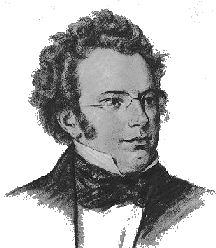RONDO IN B MINOR, FOR VIOLIN AND PIANO, OP. 70, D. 895 (RONDO BRILLANT)
Franz Schubert
(b. Vienna, Austria, January 31, 1797; d. Vienna, November 19, 1828)
Composed 1826; 14 minutes
 With regular musical practice, chamber music and daily orchestral rehearsals at the Vienna City Seminary, plus family string quartet evenings at home, the young Schubert was well trained as a violinist. He wrote this demanding Rondo in 1826 for Josef Slavík, a young Bohemian virtuoso to whom he had been introduced. Slavík performed it privately at the home of the Viennese music publisher Domenico Artaria. Three months later, Artaria added it to his catalog, titling it Rondo brillant, and it became Schubert’s only published work for violin. The Rondo is on a large scale and is prefaced by an introduction that is to generate many of the work’s ideas. The Rondo itself combines a somewhat traditional structure (ABACA, where A is the main theme and B and C are extended episodes that introduce new themes) with the rather more complex sonata rondo form. All of which means that there are many surprises in store, unexpected turns, startling stepwise shifts of key and a brilliant coda that brings back several of the themes heard earlier.
With regular musical practice, chamber music and daily orchestral rehearsals at the Vienna City Seminary, plus family string quartet evenings at home, the young Schubert was well trained as a violinist. He wrote this demanding Rondo in 1826 for Josef Slavík, a young Bohemian virtuoso to whom he had been introduced. Slavík performed it privately at the home of the Viennese music publisher Domenico Artaria. Three months later, Artaria added it to his catalog, titling it Rondo brillant, and it became Schubert’s only published work for violin. The Rondo is on a large scale and is prefaced by an introduction that is to generate many of the work’s ideas. The Rondo itself combines a somewhat traditional structure (ABACA, where A is the main theme and B and C are extended episodes that introduce new themes) with the rather more complex sonata rondo form. All of which means that there are many surprises in store, unexpected turns, startling stepwise shifts of key and a brilliant coda that brings back several of the themes heard earlier.